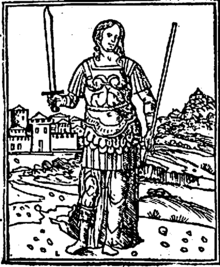
Semiramis (/səˈmɪrəmɪs, sɪ-, sɛ-/;[1] Syriac: ܫܲܡܝܼܪܵܡ Šammīrām, Armenian: Շամիրամ Šamiram, Greek: Σεμίραμις, Arabic: سميراميس Samīrāmīs) was the legendary[2][3] Lydian-Babylonian[4][5] wife of Onnes and of Ninus, who succeeded the latter on the throne of Assyria,[6] according to Movses Khorenatsi.[7] Legends narrated by Diodorus Siculus, who drew primarily from the works of Ctesias of Cnidus,[8][9] describe her and her relationships to Onnes and King Ninus.
Armenians and the Assyrians of Iraq, northeast Syria, southeast Turkey, and northwest Iran still use Shamiram as a given name for girls.[10]
The real and historical Shammuramat, the original Akkadian form of the name, was the Assyrian wife of Shamshi-Adad V (ruled 824 BC–811 BC). She ruled the Neo-Assyrian Empire as its regent for five years, before her son Adad-nirari III came of age and took the reins of power.[11] She ruled at a time of political uncertainty, which may partly explain why Assyrians may have accepted the rule of a woman when it was not allowed by their cultural tradition. She conquered much of the Middle East and the Levant and stabilized and strengthened the empire after a destructive civil war. It has been speculated that being a woman who ruled successfully may have made the Assyrians regard her with particular reverence and that her achievements may have been retold over the generations until she was gradually turned into a legendary figure.[12]
The name of Semiramis came to be applied to various monuments in Western Asia and Anatolia whose origins had been forgotten or unknown,[13] even the Behistun Inscription of Darius.[14][15] Herodotus ascribes to her the artificial banks that confined the Euphrates.[16] He knew her name because it was inscribed on a gate of Babylon.[17] Various places in Mesopotamia, Media, Persia, the Levant, Anatolia, the Arabian Peninsula, and the Caucasus received names recalling Semiramis.
- ^ Wells, John C. (2008), Longman Pronunciation Dictionary (3rd ed.), Longman, ISBN 9781405881180
- ^ Robin Lane Fox (4 September 2008). Travelling Heroes: Greeks and their myths in the epic age of Homer. Penguin UK. ISBN 978-0-14-188986-3. OCLC 1004570108.
Semiramis was an invention of the Greek legend only
- ^ Kühne, Hartmut (2008). "Sexgender, Power And Sammuramat: A View From The Syrian Steppe". Fundstellen: gesammelte Schriften zur Ärchäologie und Geschichte Altvorderasiens; ad honorem Hartmut Kühne. Otto Harrassowitz Verlag. p. 352. ISBN 978-3-447-05770-7.
- ^ Creighton M.A. L.L.D., Rev. Mandell (1888). The Historical Review. Vol. 3. London & New York: Longmans, Green, And Co. p. 112.
- ^ Yehoshua, Avram (June 7, 2011). The Lifting of the Veil: Acts 15:20-21. Trafford Publishing. p. 58. ISBN 978-1426972034.
- ^ Bernbeck 2008, p. 353.
- ^ Moses (of Khoren) (2006). History of the Armenians. Caravan Books. ISBN 978-0-88206-111-5. OCLC 1011412893.
- ^ Diodorus Siculus: The Library of History, Book II, Chapters 1-22
- ^ Muntz, Charles Edward (2017). Diodorus Siculus and the world of the late Roman republic. New York, NY: Oxford University Press. p. 23. ISBN 9780190498726.
- ^ "Assyrian Names and Meanings for Boys and Girls". www.atour.com. Retrieved 2020-08-24.
- ^ "Sammu-ramat (queen of Assyria)". Britannica Online Encyclopedia. Retrieved 2013-01-04.
- ^ Cite error: The named reference
AE2014was invoked but never defined (see the help page). - ^ See Strabo xvi. I. 2
- ^ Diodorus Siculus ii. 3
- ^ Cite error: The named reference
Reade2000was invoked but never defined (see the help page). - ^ i. 184
- ^ iii. 155